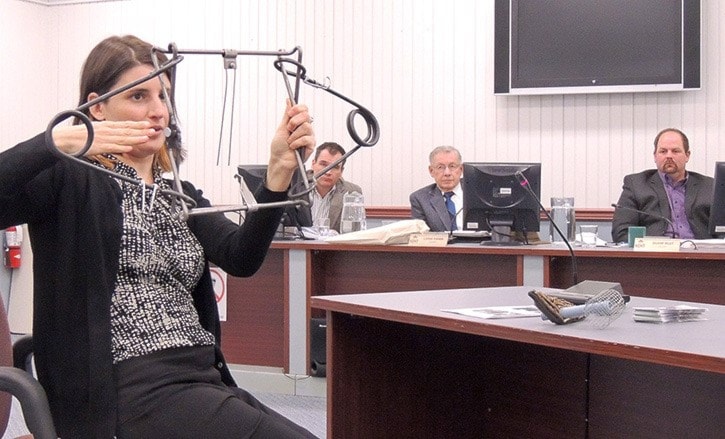There is no such thing a 'humane' animal trap, the head of a animal protection group told Kent council Monday night.
Lesley Fox, executive director of The Association for the Protection of Fur-Bearing Animals, explained the dangers of trapping and urged council to consider working with the group to find better alternatives to managing urban wildlife. One of those options was to allow her association the chance to work with the District to build a beaver dam bypass.
The most problematic wildlife in urban areas are coyotes and beavers, she said, and it's currently legal to set traps to catch and kill them. However, she pointed out, traps don't just trap nuisance animals — they trap or injure anything or anyone who comes into contact with them. And often they don't kill animals instantly, but maim them so they die slowly.
"The intention is to kill instantly," Fox said, while holding up a Conibear trip, the most popular of its kind. "But that doesn't always happen. There are so many variables."
No matter how well a trap is designed or set, she added, "you can't predict how an animal behaves when caught."
Those dangers, coupled with lax trapping regulations, dwindling numbers of Conservation officers, and lucrative trapping contracts, mean B.C. has forests, waterways, and even recreation areas filled with unmarked, hidden traps that anyone could fall prey to.
And they do, Fox said.
"I'm not trying to be sensational," she said, "but it does happen… and it's becoming more and more of a problem."
Traps can be set in creeks (for beavers), and as close as 200m to homes. Despite the fact that animals can't read, there is no requirement for posting signs about traps. When questioned by Coun. Holger Schwichtenberg about the reasoning behind that regulation, Fox said it could be to protect the hunter's traps from damage or theft.
Fox didn't focus entirely on the dangers of trapping. She also brought forward ideas for co-habitation with animals — a reality in areas like Agassiz that incorporate urban and agricultural land. The APFBA has worked with Sechelt (which has banned traps), Langley, Mission and Pender Harbour to put a water pipe through beaver dams instead of tearing them down or trapping the animals.
"Their dams are like concrete and they are persistent animals," she said. "As soon as you remove it, they'll do it again."
The cost of their pipe system can range from $300 to $800, a cost that can either be covered by the municipality, or covered through fundraising by the organization.
By contrast, the cost to pay workers to tear down a dam is much more, and trapping contracts can be as high as $10,000, she said.
Fox said they work continually with municipalities to make sure the solution is working.
Mayor John Van Laerhoven said the idea has some merit, and will be considered by staff.
"I think it's something worth looking at," he told The Observer. "They said they'd come out and work with people and it might be something that might be sufficient enough to move the water."
There may be areas in the District of Kent where it could attempted, he said.
" I don't think it should be discounted," he said. "I think it would be really neat to try something like that."
When Coun. Duane Post pointed out that beavers will keep working at their dams, and keep rebuilding, Fox said they do the same.
"We will work until it's perfect," she said.
But beyond physical solutions, education is the key, Fox said.
If you have a wildlife problem, you have a food source problem, she said. And the only way to fix that is to remove the food source.
It can mean properly removing fallen fruit from fruit trees, making sure your recycling is clean and your garbage is put out as close to pickup time as possible, and not leaving pet food outside, especially at night.
To help that along, she urged council to consider a bylaw to restrict feeding wildlife.
"The number one problem is, people feed them," she said, either intentionally or unintentionally.
"As a city, you have a good opportunity to form structure, through bylaws," she added.
For more information on trapping and urban solutions to co-habitating with wildlife, visit www.FurBearerDefenders.com.
news@ahobserver.com
